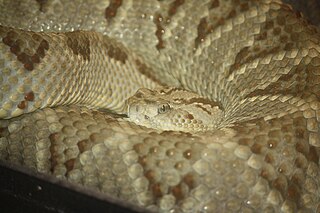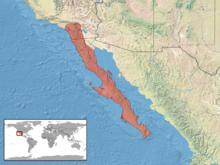
Crotalus cerastes, known as the sidewinder, horned rattlesnake or sidewinder rattlesnake, is a pit viper species belonging to the genus Crotalus, and is found in the desert regions of the Southwestern United States and northwestern Mexico. Like all other pit vipers, it is venomous. Three subspecies are currently recognized.

Crotalus is a genus of venomous pit vipers, commonly known as rattlesnakes or rattlers, in the family Viperidae. The genus is found only in the Americas from southern Canada to northern Argentina. The generic name Crotalus is derived from the Greek word κρόταλονkrótalοn, which means "rattle" or "castanet", and refers to the rattle on the end of the tail, which makes this group so distinctive. As of July 2023, 44 to 53 species are recognized as valid.

Crotalus stephensi is a venomous pitviper species found in central and southern Nevada and adjacent California. Common names include panamint rattlesnake, panamint rattler, Owens Valley rattler, and tiger rattlesnake.

The eastern diamondback rattlesnake is a species of pit viper in the family Viperidae. The species is endemic to the Southeastern United States. It is one of the heaviest venomous snakes in the Americas and the largest rattlesnake. No subspecies are recognized.

The black-tailed rattlesnake is a venomous pit viper species found in the southwestern United States and Mexico. Four subspecies are currently recognized, including the nominate subspecies described here.

Crotalus basiliscus, known as the Mexican west coast rattlesnake, Mexican green rattler, and also by other names, is a species of pit viper in the family Viperidae. The species is endemic to western Mexico. Like all other pit vipers, it is venomous. The specific name, basiliscus, is derived from the Greek word for king, βασιλισκος, and alludes to this snake's large size and potent venom. No subspecies are currently recognized.

Crotalus helleri or Crotalus oreganus helleri, also known commonly as the Southern Pacific rattlesnake, the black diamond rattlesnake, and by several other common names, is a pit viper species or subspecies found in southwestern California and south into Baja California, Mexico, that is known for its regional variety of dangerous venom types. It is sometimes considered a subspecies of Crotalus oreganus.

Crotalus willardi is a venomous pit viper species found in the southwestern United States and Mexico. This snake is found mainly in the "sky island" region. The IUCN reports this snake's conservation status as being of Least Concern. It is the official state reptile of Arizona.

The western diamondback rattlesnake or Texas diamond-back is a rattlesnake species and member of the viper family, found in the southwestern United States and Mexico. Like all other rattlesnakes and all other vipers, it is venomous. It is likely responsible for the majority of snakebite fatalities in northern Mexico and the greatest number of snakebites in the U.S. No subspecies are currently recognized.

Crotalus mitchellii is a venomous pit viper species in the family Viperidae. The species is endemic to the Southwestern United States and adjacent northern Mexico. The species was named in honor of Silas Weir Mitchell (1829–1914), an American medical doctor who also studied rattlesnake venoms. Five subspecies are currently recognized, including the nominate subspecies described here.

The Santa Catalina rattlesnake is a species of pit viper endemic to Isla Santa Catalina in the Gulf of California just off the east coast of the state of Baja California Sur, Mexico. Like all other pit vipers, it is venomous. No subspecies are currently recognized. A relatively small and slender species, its most distinctive characteristic is that it lacks a rattle. They are also a generally nocturnal species. Though the species is classified as Critically Endangered on the IUCN Red List, there are few efforts for the snake's conservation.

Sistrurus miliarius, commonly called the pygmy rattlesnake, is a species of venomous snake in the subfamily Crotalinae of the family Viperidae. The species is endemic to the Southeastern United States. Three subspecies are currently recognized.

Crotalus durissus, known as the South American rattlesnake, tropical rattlesnake, and by other names, is a highly venomous pit viper species found in South America. It is the most widely distributed member of its genus. Currently, seven subspecies are recognized.

Crotalus simus is a venomous pit viper species found in Mexico and Central America. The specific epithet is Latin for "flat-nosed", likely because its head is blunt compared with lanceheads (Bothrops). Three subspecies are recognized, including the nominate subspecies described here.

Crotalus oreganus, commonly known as the Western rattlesnake or northern Pacific rattlesnake, is a venomous pit viper species found in western North America from the Baja California Peninsula to the southern interior of British Columbia.

Crotalus atrox tortugensis is a venomous pit viper subspecies found only on Tortuga Island in the Gulf of California.

The tiger rattlesnake is a highly venomous pit viper species found in the southwestern United States and northwestern Mexico. No subspecies are currently recognized. The specific name tigris,, refers to the many narrow dorsal crossbands, which create a pattern of vertical stripes when viewed from the side.

Crotalus pricei is a species of venomous snake, a pit viper in the family Viperidae. The species is endemic to the southwestern United States and northern Mexico. Two subspecies are recognized.
Crotalus lorenzoensis is a species of pit viper.
Crotalus ruber lucasensis is a venomous pitviper subspecies found in Mexico in the Cape region of lower Baja California.





















